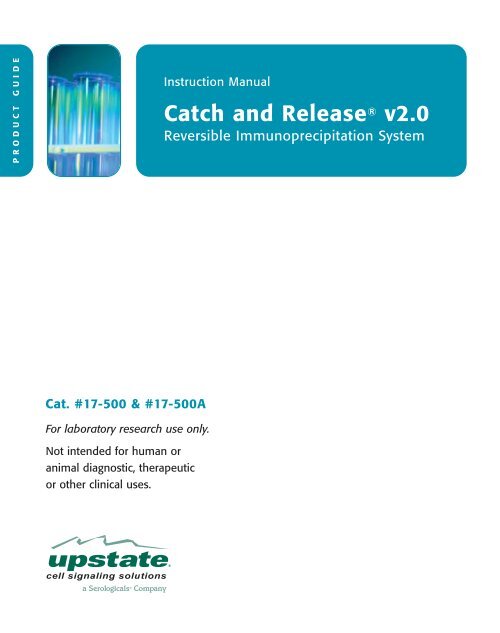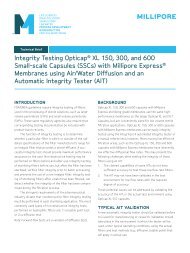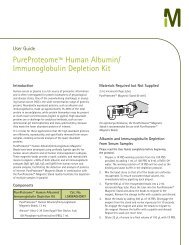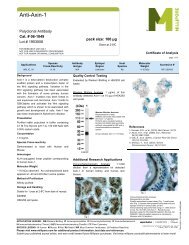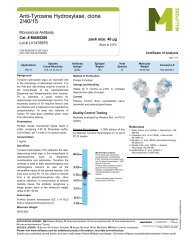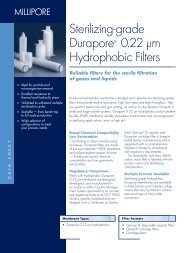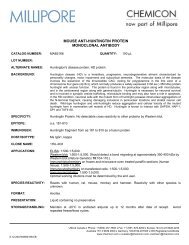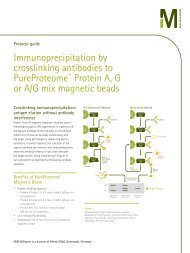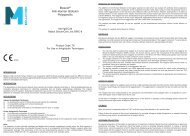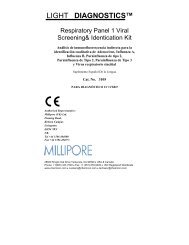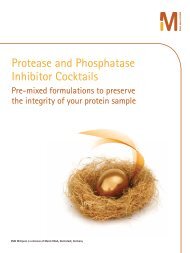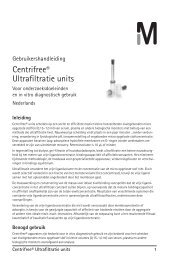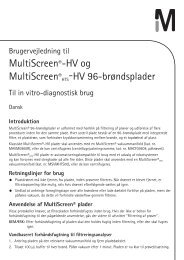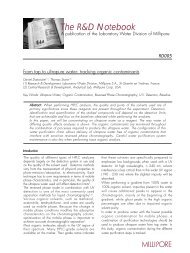Catch and Release® v2.0 - Millipore
Catch and Release® v2.0 - Millipore
Catch and Release® v2.0 - Millipore
Create successful ePaper yourself
Turn your PDF publications into a flip-book with our unique Google optimized e-Paper software.
PRODUCT GUIDE<br />
Cat. #17-500 & #17-500A<br />
For laboratory research use only.<br />
Not intended for human or<br />
animal diagnostic, therapeutic<br />
or other clinical uses.<br />
Instruction Manual<br />
<strong>Catch</strong> <strong>and</strong> Release ® <strong>v2.0</strong><br />
Reversible Immunoprecipitation System
contents<br />
I. Introduction <strong>and</strong> Principle....................................4<br />
II. System Components ..............................................8<br />
A. Reagents Supplied<br />
B. Required Materials Not Provided<br />
C. Preparation of Reagents<br />
III. <strong>Catch</strong> <strong>and</strong> Release ®<br />
Immunoprecipitation Procedure ......................12<br />
A. Optimizing Incubation Time <strong>and</strong> Temperature<br />
B. <strong>Catch</strong> <strong>and</strong> Release ® Protocol<br />
IV. Technical Support ................................................21<br />
A. Frequently Asked Questions<br />
B. Troubleshooting<br />
V. <strong>Catch</strong> <strong>and</strong> Release ® vs.<br />
Traditional Immunoprecipitation Data ............27<br />
VI. References ............................................................32<br />
Cat. #17-500 & #17-500A<br />
3
<strong>Catch</strong> <strong>and</strong> Release ® Reversible Immunoprecipitation System<br />
4<br />
I. Introduction <strong>and</strong> Principle<br />
Immunoprecipitation (IP) is a frequently used method to<br />
purify specific proteins from complex samples such as cell<br />
lysates or extracts. Traditional IP protocols use Protein A<br />
or Protein G coupled to an insoluble resin, such as agarose<br />
beads, to capture an antigen:antibody complex in solution.<br />
The complex is then “precipitated” by centrifugation. Limitations<br />
of traditional IP include sample h<strong>and</strong>ling <strong>and</strong> processing<br />
difficulties, the inability to release native antigen from the<br />
beads for functional assays <strong>and</strong> poor reproducibility <strong>and</strong><br />
recovery due to multiple wash steps.<br />
<strong>Catch</strong> <strong>and</strong> Release ® overcomes many of the limitations<br />
associated with traditional IP. Its unique Spin-Column format<br />
was designed to make IP faster, simpler <strong>and</strong> more reproducible.<br />
<strong>Catch</strong> <strong>and</strong> Release ® enables the elution of the antigen:antibody<br />
complex without denaturation, while ensuring minimal<br />
contamination by non-specific proteins in the eluate. In<br />
addition, the convenient Spin-Column format of <strong>Catch</strong><br />
<strong>and</strong> Release ® improves performance <strong>and</strong> makes higher<br />
throughput processing of samples possible.<br />
<strong>Catch</strong> <strong>and</strong> Release ® Columns contain a proprietary<br />
resin in a microfuge-compatible Spin Column secured by<br />
a screw cap top <strong>and</strong> a breakaway closure on the bottom.<br />
An Antibody Capture Affinity Lig<strong>and</strong>, for binding the
Cat. #17-500 & #17-500A<br />
antigen:antibody complex, is also provided <strong>and</strong> serves as<br />
a tether between the complex <strong>and</strong> the resin. Most lysate<br />
proteins <strong>and</strong> antibodies will exhibit little or no binding to<br />
the resin without the Antibody Capture Affinity Lig<strong>and</strong>. It<br />
is this feature that enables the fast <strong>and</strong> simple elution of<br />
the antigen:antibody complex from the resin in either a<br />
denatured or native form.<br />
<strong>Catch</strong> <strong>and</strong> Release ® has been successfully tested<br />
on a number of proteins with both rabbit <strong>and</strong> mouse<br />
antibodies (see table 1, page 6). As little as 30 minutes<br />
of incubation with most antibodies can provide the desired<br />
results, demonstrating a significant time advantage to<br />
researchers as compared with traditional IP methods.<br />
5
<strong>Catch</strong> <strong>and</strong> Release ® Reversible Immunoprecipitation System<br />
Table 1: Select Proteins Tested with <strong>Catch</strong> <strong>and</strong> Release ®<br />
6<br />
Protein<br />
Mol. Weight Upstate Ab<br />
(kDa) Cat. #<br />
Akt-1 65 **<br />
AUF1 45 **<br />
Caspase 3 32 06-735 Rb<br />
Caspase 6 34 06-691 Rb<br />
cdk2 33 06-505 Rb<br />
CREB 43 06-863 Rb<br />
Cyclin B1 58 05-373 M<br />
D4-GDI 28 06-731 Rb<br />
FAK 125 05-537 M<br />
FRA-1 39 **<br />
GSK3β 42 **<br />
HDAC1 65 06-720 Rb<br />
Jak2 130 06-255 Rb<br />
MEK1 45 06-269 Rb<br />
Mib1 110 **<br />
Myosin Heavy Chain 220 05-716 M<br />
NKG2D 50 **<br />
Nrf 120 **<br />
Host
Protein<br />
Paxillin 68 **<br />
phospho-Tyrosine – 05-777 M<br />
phospho-Tyrosine – 06-427 Rb<br />
PLC-γ-1 135 05-163 M<br />
PP2A 36 05-421 M<br />
M-mouse, Rb-rabbit<br />
Mol. Weight<br />
(kDa)<br />
** tested using investigator-supplied antibody<br />
Cat. #17-500 & #17-500A<br />
Cat. # Host<br />
Proteins have also been tested with antibodies to the following<br />
epitope tags:<br />
• Flag<br />
• GFP<br />
• HA<br />
• Myc<br />
Note: <strong>Catch</strong> <strong>and</strong> Release ® is not suitable to immunoprecipitate<br />
proteins expressing 6X Histidine epitope tagged fusion proteins<br />
(i.e., His-tagged fusion proteins) due to non-specific interactions<br />
with the resin.<br />
7
<strong>Catch</strong> <strong>and</strong> Release ® Reversible Immunoprecipitation System<br />
8<br />
II. System Components<br />
A. Reagents Supplied*<br />
• Antibody Capture Affinity Lig<strong>and</strong>:<br />
One vial containing 60 µg Antibody Capture Affinity<br />
Lig<strong>and</strong> in 500 µl PBS containing 10% glycerol <strong>and</strong><br />
2 mM PMSF. Store at 4ºC. Stable for 6 months.<br />
• <strong>Catch</strong> <strong>and</strong> Release ® Wash Buffer, 10X:<br />
One vial containing 15 ml of 10X buffer, pH 7.4<br />
containing the following detergents: 10% NP-40 <strong>and</strong><br />
2.5% deoxycholic acid. Liquid at 4ºC. Stable for two<br />
years. Note: If crystallization occurs when buffer is<br />
stored at 4ºC, warm to room temperature <strong>and</strong> vortex<br />
briefly before use.<br />
• Non-denaturing Elution Buffer, 4X:<br />
One vial containing 10 ml of 4X PBS based IP Elution<br />
Buffer. Store at 4ºC. Stable for two years.<br />
• Denaturing Elution Buffer, 1X:<br />
One vial containing 4 ml of 1X PBS based IP Elution<br />
Buffer. Add β-Mercaptoethanol (βME; not provided)<br />
to a final concentration of 5% (v/v) immediately<br />
before use. Store at 4ºC. Stable for one year.
• <strong>Catch</strong> <strong>and</strong> Release ® Spin Columns:<br />
50 columns containing 0.5 ml (20% w/v) of IP<br />
capture resin in suspension.<br />
• <strong>Catch</strong> <strong>and</strong> Release ® Capture Tubes:<br />
100 reservoir tubes.<br />
* The <strong>Catch</strong> <strong>and</strong> <strong>Release®</strong> Sample Pack (cat. # 17-500A)<br />
contains 1/10 the amount of reagents supplied in the regular<br />
pack size (cat. #17-500)<br />
B. Required Materials Not Provided<br />
• Cell Lysates<br />
• Specific primary antibodies<br />
• Milli-Q ® water<br />
• Pipettes <strong>and</strong> tips<br />
• Microcentrifuge<br />
• Rotator or rocker<br />
• Forceps<br />
• Microcentrifuge tubes<br />
If performing Western blots<br />
on immunoprecipitated material:<br />
• SDS-PAGE reagents <strong>and</strong> apparatus<br />
• Western blotting reagents <strong>and</strong> apparatus<br />
Cat. #17-500 & #17-500A<br />
9
<strong>Catch</strong> <strong>and</strong> Release ® Reversible Immunoprecipitation System<br />
10<br />
• PVDF or other membrane<br />
• Saran Wrap ®<br />
• Kimwipes ®<br />
• Specific primary antibodies<br />
• Wash buffer<br />
• Blocking buffer<br />
• X-ray film <strong>and</strong> dark room or digital imaging system<br />
• Ponceau Stain (optional)<br />
• Stripping buffers (optional)<br />
• Membrane incubation containers<br />
• Timer<br />
Other recommended kits:<br />
1. For Western blot detection:<br />
• Visualizer Western Blot Detection Kit,<br />
mouse (cat. #64-201)<br />
• Visualizer Western Blot Detection Kit,<br />
rabbit (cat. # 64-202)<br />
• ChemiBlot Molecular Weight Markers,<br />
(cat. #2230)<br />
• BLOT - FastStain (cat. #2076)<br />
• ChemiBLOCKER (cat. #2170)
Cat. #17-500 & #17-500A<br />
• ReBlot Western Blot Recycling Kit (cat. # 2060)<br />
• ReBlot Plus Western Blot Recycling Kit<br />
(cat. #2500)<br />
2. For negative immunoprecipitation (IP) species controls:<br />
• Normal Mouse IgG (cat. #12-371)<br />
• Normal Rabbit IgG (cat. #12-370)<br />
• Mouse Serum (cat. #S25-10ML)<br />
• Rabbit Serum (cat. #S20-100ML)<br />
C. Preparation of Reagents<br />
• Unless otherwise noted, all dilutions of stock<br />
reagents provided in the kit are to be done with<br />
high-quality water, such as Milli-Q ® water.<br />
• If gel electrophoresis is to be performed, it should<br />
be done according to the specifications set by the<br />
manufacturers of the gel <strong>and</strong> the apparatus, taking<br />
into consideration the specific protein(s) that need<br />
to be resolved.<br />
• When transferring the resolved proteins to a<br />
membrane, follow the recommendations set<br />
by the manufacturer of the transfer apparatus.<br />
• IP with <strong>Catch</strong> <strong>and</strong> Release ® <strong>and</strong> Western blot detection<br />
with Visualizer is compatible with either nitrocellulose<br />
or PVDF membranes.<br />
11
<strong>Catch</strong> <strong>and</strong> Release ® Reversible Immunoprecipitation System<br />
12<br />
III. <strong>Catch</strong> <strong>and</strong> <strong>Release®</strong> Procedure<br />
A. Optimizing Incubation Time <strong>and</strong> Temperature<br />
The <strong>Catch</strong> <strong>and</strong> Release ® procedure as outlined below uses<br />
incubation times <strong>and</strong> temperatures that have been demonstrated<br />
to work well with antibodies for many proteins* (see table 1,<br />
page 6). If these conditions differ from the conditions<br />
used in your traditional IP procedure, you should follow<br />
your traditional method in your first use of the kit. For<br />
example, if you normally incubate a sample with your primary<br />
antibody for 1 hour at 4ºC, then you should do the same<br />
in Step 5 (see page 15). Once you have verified that<br />
<strong>Catch</strong> <strong>and</strong> Release ® works with your antibody <strong>and</strong> protein,<br />
you may choose to optimize the procedure by adjusting<br />
incubation times. Some antibodies will exhibit optimal<br />
antigen binding in as little as 10-15 minutes, others may<br />
require an overnight incubation; some incubations will<br />
work at room temperature, while others are best performed<br />
at 4ºC. These two key parameters should be empirically<br />
determined by the researcher for every antibody, lysate<br />
<strong>and</strong> protein of interest.<br />
* <strong>Catch</strong> <strong>and</strong> Release ® should not be used to IP His-tagged proteins
Cat. #17-500 & #17-500A<br />
B. <strong>Catch</strong> <strong>and</strong> Release ® Protocol<br />
1. Dilute enough 10X <strong>Catch</strong> <strong>and</strong> Release ® Wash Buffer<br />
to the 1X working concentration with Milli-Q ® water for<br />
incubation <strong>and</strong> all washes. You will need approximately<br />
2.5 ml for washes <strong>and</strong> some additional volume possibly<br />
for the antibody incubation (Step 4).<br />
2. Label the Spin Columns, Capture Tubes <strong>and</strong> microcentrifuge<br />
tubes to be used. Remove the snap-off bottom plug<br />
(save for later use; see figure 1), <strong>and</strong> insert the Spin<br />
Column into a Capture Tube. Remove the screw-on<br />
cap <strong>and</strong> centrifuge at 5000 rpm (2000 xg) for 15-30<br />
seconds to remove the resin slurry buffer. Wash the<br />
resin twice with 400 µl 1X Wash Buffer. Empty the<br />
Capture Tube, <strong>and</strong> plug the bottom end of the<br />
Column with the snap-off bottom plug.<br />
Figure 1<br />
{<br />
remove the<br />
snap-off<br />
bottom plug<br />
snap-off<br />
bottom<br />
plug snap-off<br />
here<br />
invert the<br />
bottom plug<br />
reinsert the<br />
bottom plug<br />
for incubation<br />
13
<strong>Catch</strong> <strong>and</strong> Release ® Reversible Immunoprecipitation System<br />
14<br />
3. Determine the volume of combined reagents:<br />
a. 500 µg of cell lysate. Notes: 1. This is a recommended<br />
starting amount, but the optimal amount may need to<br />
be empirically determined for each individual antibody<br />
<strong>and</strong> antigen. 2. High concentrations (>1mM) of reducing<br />
agents, such as dithiothreitol (DTT) or β-mercaptoethanol<br />
(βME), may denature antigens or antibodies<br />
<strong>and</strong> prevent capture.<br />
b. 1-4 µg of a specific primary antibody <strong>and</strong> negative<br />
control antibody. 5-10 µl of whole antiserum or ascites<br />
fluid. Note: These are recommended starting amounts<br />
but the optimal amounts may need to be empirically<br />
determined for each individual antibody <strong>and</strong> sample<br />
containing antigen. Upstate highly recommends<br />
performing corresponding negative IP controls (for<br />
any immunoprecipitation procedure) as side-by-side<br />
comparison. Please see page 11 for a listing of<br />
recommended negative IP control antibodies.<br />
c. 10 µl of Antibody Capture Affinity Lig<strong>and</strong><br />
d. Sufficient 1X Wash Buffer to provide a final total<br />
volume of 500 µl
Component Amount<br />
Cell Lysate _____ µl<br />
Antibody _____ µl<br />
Affinity Lig<strong>and</strong> 10 µl<br />
1X Wash Buffer _____ µl<br />
Total 500 µl<br />
Cat. #17-500 & #17-500A<br />
4. With the bottom end of the Spin Column plugged,<br />
add the reagents in the following order to the column:<br />
a. 1X Wash Buffer<br />
b. Cell lysate<br />
c. Specific primary antibody or negative control antibody<br />
d. Antibody Capture Affinity Lig<strong>and</strong><br />
5. Cap the top of the Column (using the screw-on cap),<br />
<strong>and</strong> incubate on a rotator or mixer at room temperature<br />
for 30 minutes (see page 12 for more information on<br />
incubation times <strong>and</strong> temperatures), ensuring that the<br />
slurry remains suspended during incubation.<br />
6. Remove the snap-off bottom plug <strong>and</strong> discard. Place<br />
the Column in the Capture tube. Remove the screw-on<br />
cap <strong>and</strong> centrifuge at 5000 rpm (2000 xg) for<br />
15-30 seconds to collect flow-through. Transfer the<br />
flow-through to a microcentrifuge tube <strong>and</strong> save for<br />
Western blot analysis, if desired (it may be useful for<br />
trouble-shooting, if necessary).<br />
15
<strong>Catch</strong> <strong>and</strong> Release ® Reversible Immunoprecipitation System<br />
16<br />
7. Wash the Column 3X with 400 µl of 1X Wash Buffer,<br />
spinning at 5000 rpm (2000 xg) 15-30 seconds for<br />
each wash. Washes may be saved (if desired) for<br />
Western blot analysis <strong>and</strong> trouble-shooting.<br />
8. Place the Column into a fresh Capture Tube.<br />
9. Proteins may be eluted from the Column in either a<br />
denatured form (i.e. for SDS-PAGE <strong>and</strong> Western blotting),<br />
or a native form, following 9A or 9B.<br />
9A. For elution of protein in its denatured, reduced form:<br />
Add 70 µl of 1X Denaturing Elution Buffer containing<br />
βME to the Spin Column. Centrifuge <strong>and</strong> save eluate<br />
for Western analysis. Note: This can be done as an<br />
additional step after Step 9B.<br />
9B. For elution of protein in its native form: Dilute 4X<br />
Non-Denaturing Elution Buffer to 1X, <strong>and</strong> add 70 µl<br />
to the Spin Column. Centrifuge the Spin Column at<br />
5000 rpm (2000 xg), <strong>and</strong> save the eluate for Western<br />
analysis or other assays. Notes: 1. Additional elutions<br />
with 2X or 4X Non-Denaturing Elution Buffer can be<br />
done for maximum recovery of bound material.<br />
2. Successive elutions using either or both protocols<br />
(Steps 9A <strong>and</strong>/or 9B) may allow a more complete<br />
recovery of the antigen; see figures 1-3 (lanes 5-7)<br />
on pages 27-29.
Cat. #17-500 & #17-500A<br />
9C. <strong>Catch</strong> <strong>and</strong> Release ® Immunoprecipitation Kinase<br />
Assay (IPK) Protocol<br />
To perform a kinase assay using the eluted protein in<br />
its native form (i.e., non-denaturing elution listed in<br />
step 9B.), the <strong>Catch</strong> <strong>and</strong> Release ® kit was used with<br />
Upstate’s polyclonal antibody, Anti-Erk1/2 (cat. #06-182)<br />
which immunoprecipates active Erk1/2. Active Erk1/2<br />
was eluted <strong>and</strong> used in conjunction with Upstate’s nonradioactive<br />
MAP Kinase/Erk Assay Kit (cat. #17-191).<br />
The non-radioactive MAP Kinase/Erk assay kit is<br />
designed to measure the phosphotransferase activity<br />
of MAP (mitogen-activated protein) Kinase (also<br />
known as Erk1/2) in immunoprecipitates. The assay<br />
kit is based on phosphorylation of a specific substrate<br />
(myelin basic protein, MBP). The phosphorylated<br />
substrate is then analyzed by immunoblot analysis,<br />
probing with a monoclonal Phospho-specific<br />
MBP antibody.<br />
Cell Lysate Preparation<br />
Rat Pheochromocytoma (PC-12) cells grown to<br />
sub-confluence <strong>and</strong> serum starved overnight. To<br />
activate Map Kinase, the cells were stimulated with<br />
NGF (50 ng/ml for 10 mins at 37°C) <strong>and</strong> were lysed<br />
in ice cold buffer A (50 mM Tris, pH 7.5, 1 mM<br />
17
<strong>Catch</strong> <strong>and</strong> Release ® Reversible Immunoprecipitation System<br />
18<br />
EDTA, 1 mM EGTA, 0.5mM Na3VO4, 0.1% 2-mercaptoethanol,<br />
1% Triton X-100, 50 mM sodium fluoride,<br />
5mM sodium pyrophosphate, 10 mM sodium β-glycerol<br />
phosphate, 0.1mM PMSF, 1 mg/ml of aprotinin, pepstatin,<br />
leupeptin <strong>and</strong> 1mM Microcystin). Microcystin<br />
was added to ensure complete inactivation of cellular<br />
PP1 <strong>and</strong> PP2A phosphatases, which may dephosphorylate<br />
the active MAP Kinase.<br />
Any insoluble material after cell lysis was pelleted<br />
by centrifugation at 16,000 xg for 10 minutes at 4°C.<br />
A Bradford assay, using BSA as a st<strong>and</strong>ard, was used<br />
to assess total protein concentration of the cell lysate.<br />
The cell lysate was diluted to 1 mg/ml with ice cold<br />
buffer A prior to performing the immunoprecipitation<br />
to maintain kinase activity.<br />
<strong>Catch</strong> <strong>and</strong> Release ® IPK (Protocol to IP Active Kinase)<br />
4 µg of negative normal rabbit IgG <strong>and</strong>/or 4 µg of anti-<br />
Erk1/2 was used as described in the instruction manual;<br />
except that at step 7, page 16, the final column wash<br />
was performed with Kinase Assay Dilution Buffer (ADB)<br />
included in non-radioactive MAP Kinase/Erk assay kit<br />
(cat. #17-191), <strong>and</strong> the eluate was diluted 1X (i.e., the<br />
70 µl eluate in step 9B was diluted equally with ADB).
Cat. #17-500 & #17-500A<br />
All kinase reactions were performed using either normal<br />
IgG (negative control) or anti-Erk1/2, <strong>and</strong> were performed<br />
in a total volume of 50 µl. Reactions were at 30°C for<br />
30 minutes with mixing:<br />
Component Amount<br />
MAP Kinase Substrate<br />
Cocktail (cat. #20-166) 10 µl<br />
Magnesium/ATP<br />
Cocktail (cat. #20-113) 10 µl<br />
Assay Dilution<br />
Buffer (cat. #20-108) 10 µl<br />
Eluate of<br />
IP material 20 µl<br />
Total 50 µl<br />
After the incubation time, 50 µl kinase reactions were<br />
diluted in 2X Laemmli sample buffer/reducing sample<br />
buffer for a final volume of 100 µl. The samples were<br />
boiled for 5 minutes, <strong>and</strong> 20 µl out of the 100 µl boiled<br />
sample was loaded on an Invitrogen 4-12% Bis-Tris gel<br />
using MES running buffer (concentration of MBP substrate<br />
loaded is 2 µg per lane), <strong>and</strong> protein was transferred<br />
to nitrocellulose <strong>and</strong>/or PVDF <strong>and</strong> probed with<br />
anti-phospho-MBP following the instructions contained<br />
19
<strong>Catch</strong> <strong>and</strong> Release ® Reversible Immunoprecipitation System<br />
20<br />
within the non-radioactive MAP Kinase/Erk assay kit’s<br />
datasheet. Note: An equal amount was used in all<br />
<strong>Catch</strong> <strong>and</strong> Release ® <strong>and</strong> traditional immunoprecipitation<br />
conditions (500 µg total cellular protein was used).<br />
Please see IPK data on Figure 4; page 30 for both<br />
<strong>Catch</strong> <strong>and</strong> Release ® <strong>and</strong> traditional IP. Experiments<br />
were normalized so that equivalent amounts of <strong>Catch</strong><br />
<strong>and</strong> Release ® eluate or traditional IP using Protein A<br />
agarose beads were used with the non-radioactive MAP<br />
Kinase Assay Kit.<br />
Traditional IPK (Protocol to IP Active Kinase)<br />
4 µg of negative normal rabbit IgG <strong>and</strong>/or 4 µg of anti-<br />
Erk1/2 were bound to 30 µl of protein A beads for<br />
30 minutes. Then 500 µg of PC12 lysate in Buffer A was<br />
added, <strong>and</strong> the antibody-agarose complex <strong>and</strong> incubated<br />
at 4°C for 1 hour on a rotator. The agarose complex was<br />
pelleted <strong>and</strong> washed 2 times with buffer A <strong>and</strong> once with<br />
1X kinase assay dilution buffer.<br />
The total volume of the Protein A beads was adjusted to<br />
match that of the eluate from the <strong>Catch</strong> <strong>and</strong> Release ® kit.<br />
An equal volume of each immunoprecipitation added to<br />
the kinase reaction using non-radioactive MAP Kinase/Erk<br />
assay kit.
IV. Technical Support<br />
Cat. #17-500 & #17-500A<br />
A. <strong>Catch</strong> <strong>and</strong> Release: Frequently Asked Questions<br />
1. Q: What is the blue eluate sometimes seen after<br />
initial washes?<br />
A: This has been seen when spinning the columns<br />
at high speeds during the initial Spin Column resin<br />
washes. However, this should not affect column<br />
binding efficiency. Reducing centrifuge speed to<br />
5000 rpm (2000 xg) should eliminate the blue<br />
color in the eluate.<br />
2. Q: What should the user do if a viscous precipitate<br />
forms in the column during the initial<br />
incubation step?<br />
A: Genomic DNA is present in the lysate. Try clarifying<br />
the lysate by spinning out genomic DNA at 15,000<br />
rpm for 5 minutes at 4ºC. Some of the protein of<br />
interest might also be removed in the process.<br />
Re-check protein concentration of the clarified sample,<br />
<strong>and</strong> increase volume of lysate to use if necessary.<br />
3. Q: Why did everything (i.e., my primary antibody<br />
<strong>and</strong> target protein) come through in the<br />
flow-thru <strong>and</strong> column wash fractions?<br />
A: 1. Antibody Capture Affinity Lig<strong>and</strong> not added.<br />
Repeat incubation with Lig<strong>and</strong>.<br />
21
<strong>Catch</strong> <strong>and</strong> Release ® Reversible Immunoprecipitation System<br />
22<br />
2. Expired Antibody Capture Affinity Lig<strong>and</strong>. Check shelf<br />
life of Lig<strong>and</strong>. Obtain fresh lot of Antibody Capture<br />
Affinity Lig<strong>and</strong> if needed <strong>and</strong> repeat incubation.<br />
3. No antibody added. Repeat incubation<br />
adding antibody.<br />
4. Antibody chosen does not perform well for<br />
immunoprecipitation methods. Choose antibody<br />
that works for IP applications <strong>and</strong> repeat.<br />
4. Q: Why are b<strong>and</strong>s faint or not present in the elution<br />
fractions <strong>and</strong> flow-thru?<br />
A: 1. Insufficient exposure time during Western blot<br />
detection procedure. Increase exposure time<br />
on x-ray film or digital imaging system.<br />
2. Antibody concentration not sufficient or not optimized<br />
for either IP or Western detection. Repeat procedures<br />
with increased primary antibody concentration.<br />
3. Secondary antibody concentration is not optimal.<br />
Optimize for Western detection, <strong>and</strong> re-probe blot<br />
after stripping.<br />
4. Western detection reagents old or expired.<br />
Retry using fresh reagents.<br />
5. Cell lysate contained low levels of antigen.<br />
6. Antibody not optimal for IP. Re-evaluate it in a<br />
traditional IP.<br />
7. Increase incubation time for IP.
B. Western Detection Problems: Troubleshooting<br />
Cat. #17-500 & #17-500A<br />
Smeared Pattern or Distorted B<strong>and</strong>s<br />
• Uneven contact between gel <strong>and</strong> membrane:<br />
Cassettes used should allow a tight fit, leading to<br />
even pressure over the entire surface of the gel<br />
<strong>and</strong> membrane.<br />
• For Tris-Glycine gels, gel not equilibrated in buffer<br />
prior to transfer: The gel should be soaked in Towbin<br />
transfer buffer containing methanol for 15-30 minutes<br />
before assembling the transfer s<strong>and</strong>wich. For precast<br />
gels, make sure to follow the manufacturer's instructions<br />
for gel preparation for transfer.<br />
“Bald Spots”<br />
• Bubbles between gel <strong>and</strong> membrane: Bubbles<br />
create areas of low transfer efficiency. Bubbles should<br />
be completely removed when putting together the<br />
transfer s<strong>and</strong>wich.<br />
Incomplete Transfer<br />
• Incomplete protein transfer: This often occurs with<br />
high molecular weight proteins, especially when using<br />
a methanol-based transfer buffer. One way to prevent<br />
this is by using a nylon membrane, which does not<br />
23
<strong>Catch</strong> <strong>and</strong> Release ® Reversible Immunoprecipitation System<br />
24<br />
require methanol in the transfer buffer. Adding SDS<br />
to the transfer buffer <strong>and</strong> using higher field strengths<br />
also improve protein transfer.<br />
• Proteins transferred through membrane: This may<br />
occur when working with proteins of very low molecular<br />
weight. Optimizing/shortening transfer times <strong>and</strong> using<br />
a double layer of membrane usually enhances retention<br />
of small proteins. PVDF membranes are superior to<br />
nitrocellulose for preventing proteins from transferring<br />
through the membrane. In some cases, use of nitrocellulose<br />
or PVDF membranes with a 0.2 µm pore size<br />
works better for small proteins than membranes with<br />
the more common 0.45 µm pore size.<br />
• Inappropriate transfer buffer used: The most stable<br />
<strong>and</strong> commonly used buffers are Tris-Glycine based<br />
(Towbin Transfer Buffer).<br />
• Impurities in the transfer buffer: This will lead to<br />
a pattern on the membrane that mirrors the holes in<br />
the transfer cassette. Fresh buffer should be prepared<br />
for each transfer.<br />
• The wrong transfer buffer was used based on the<br />
isoelectric point (pI) of the protein being detected:<br />
The pH of the transfer buffer used <strong>and</strong> the pI of the<br />
protein being detected will determine the direction of
Cat. #17-500 & #17-500A<br />
the protein transfer. If the pH of the buffer <strong>and</strong> the pI<br />
of the protein are near equal, the protein will remain<br />
in the gel. If the pH of the buffer is lower than the pI<br />
of the protein, the protein will have a net negative<br />
charge <strong>and</strong> migrate towards the positive electrode. If<br />
the pH of the buffer is higher than the pI of the protein,<br />
the protein will have a net positive charge <strong>and</strong> migrate<br />
towards the negative electrode. Adding SDS to the<br />
buffer is one way to make sure all proteins in the gel<br />
have a net negative charge <strong>and</strong>, therefore, migrate<br />
towards the positive electrode. For pre-cast, neutral<br />
pH gels, consult the manufacturers instructions.<br />
High Background<br />
• Cross-reactivity between blocking agent <strong>and</strong><br />
primary antibody: This will result in overall membrane<br />
background. Usually, the addition of detergent (Tween ®-20)<br />
to the Washing Buffer will eliminate the problem. If<br />
background persists, changing the blocking agent<br />
is recommended. A blot performed without a primary<br />
but with the secondary may be useful in identification<br />
of background caused by the primary or secondary.<br />
• Concentration of either primary <strong>and</strong>/or secondary<br />
antibody too high or incubation time too long:<br />
25
<strong>Catch</strong> <strong>and</strong> Release ® Reversible Immunoprecipitation System<br />
26<br />
The higher the antibody concentration <strong>and</strong> the longer<br />
the incubation time, the greater the non-specific binding.<br />
Raising the incubation temperature (e.g. to 37ºC) is<br />
recommended over lengthening the incubation time.<br />
Also, many short washing steps are better than a few<br />
long ones.<br />
• Membrane drying during incubation process: Care<br />
should be taken to keep membrane from drying out<br />
during incubation.<br />
Little or No Signal<br />
• Antigen is not recognized by primary antibody: This<br />
can occur especially with monoclonal antibodies that<br />
were raised against a native protein. In some cases, a<br />
non-reducing gel system may need to be used.<br />
• Inhibition of secondary antibody conjugate: HRPlabeled<br />
antibodies should not be used in conjunction<br />
with sodium azide or hemoglobin.<br />
• Detergent is too harsh: SDS, Nonidet P-40 <strong>and</strong> Triton<br />
X-100 disrupt binding between proteins. Tween ®-20 is the<br />
most commonly used <strong>and</strong> recommended detergent for<br />
washing <strong>and</strong> incubation solutions.
V. <strong>Catch</strong> <strong>and</strong> <strong>Release®</strong> vs.<br />
Traditional Immunoprecipitation Data<br />
Cat. #17-500 & #17-500A<br />
Figure 1. <strong>Catch</strong> <strong>and</strong> Release ® with non-denaturing elution<br />
A B<br />
1 2 3 4 5 6 7 8 9<br />
1 2 3 4 5 6 7 8 9<br />
▲<br />
▲<br />
Legend. <strong>Catch</strong> <strong>and</strong> Release ® Spin columns <strong>and</strong> protocol<br />
were used with the Non-denaturing Elution Buffer to<br />
immunoprecipitate cdk2. HeLa nuclear extract was mixed<br />
with A. anti-cdk2 (cat. #06-505) or B. normal, rabbit IgG<br />
as a negative control for 1 hour at room temperature.<br />
Samples from each fraction were run on an SDS-PAGE gel<br />
<strong>and</strong> immunoblotted. The upper b<strong>and</strong> is the heavy chain of<br />
IgG <strong>and</strong> the lower b<strong>and</strong> is cdk2. Lane 1: flow through,<br />
Lane 2: wash 1, Lane 3: wash 2, Lane 4: wash 3,<br />
Lane 5: elution 1, Lane 6: elution 2, Lane 7: elution 3,<br />
Lane 8: anti-cdk2, Lane 9: HeLa nuclear extract.<br />
IgG Heavy<br />
Chain<br />
cdk2<br />
27
<strong>Catch</strong> <strong>and</strong> Release ® Reversible Immunoprecipitation System<br />
28<br />
Figure 2. <strong>Catch</strong> <strong>and</strong> <strong>Release®</strong> with denaturing elution<br />
A B<br />
1 2 3 4 5 6 7 8 9<br />
1 2 3 4 5 6 7 8 9<br />
▲<br />
▲<br />
Legend. <strong>Catch</strong> <strong>and</strong> Release ® columns <strong>and</strong> protocol were<br />
used with the denaturing elution buffer to immunoprecipitate<br />
cdk2. HeLa nuclear extract was mixed with A. anti-CDK2<br />
(cat. #06-505) or B. normal, rabbit IgG as a negative<br />
control for 1 hour at room temperature. Samples from each<br />
fraction were run on an SDS-PAGE gel <strong>and</strong> immunoblotted.<br />
The upper b<strong>and</strong> is the heavy chain of IgG <strong>and</strong> the lower<br />
b<strong>and</strong> is cdk2. Lane 1: flow through, Lane 2: wash 1,<br />
Lane 3: wash 2, Lane 4: wash 3, Lane 5: elution 1,<br />
Lane 6: elution 2, Lane 7: elution 3, Lane 8: anti-CDK2,<br />
Lane 9: HeLa nuclear extract.<br />
IgG Heavy<br />
Chain<br />
cdk2
Figure 3. Traditional IP with denaturing elution<br />
A B<br />
1 2 3 4 5 6 7 8 9<br />
1 2 3 4 5 6 7 8 9<br />
Cat. #17-500 & #17-500A<br />
▲<br />
▲<br />
Legend. Traditional immunoprecipitation was performed<br />
for cdk2 using Protein A agarose <strong>and</strong> the denaturing<br />
elution buffer. HeLa nuclear extract was mixed with<br />
A. anti-cdk2 (cat. #06-505) or B. normal, rabbit IgG as a<br />
negative control for 1 hour at room temperature. Samples<br />
from each fraction were run on an SDS-PAGE gel <strong>and</strong><br />
immunoblotted. The upper b<strong>and</strong> is the heavy chain of IgG<br />
<strong>and</strong> the lower b<strong>and</strong> is cdk2. Lane 1: unbound, Lane 2:<br />
wash 1, Lane 3: wash 2, Lane 4: wash 3, Lane 5: elution<br />
1, Lane 6: elution 2, Lane 7: elution 3, Lane 8: anti-CDK2,<br />
Lane 9: HeLa nuclear extract.<br />
IgG Heavy<br />
Chain<br />
cdk2<br />
29
<strong>Catch</strong> <strong>and</strong> Release ® Reversible Immunoprecipitation System<br />
30<br />
Figure 4. <strong>Catch</strong> <strong>and</strong> <strong>Release®</strong> with non-denaturing elution<br />
to immunoprecipitate active kinase.<br />
97<br />
66<br />
45<br />
31<br />
21<br />
14<br />
1 2 3 4<br />
Legend. Immunoprecipitation Kinase Assay was performed<br />
using NGF-treated PC-12 cells lysed with Buffer A (see<br />
Certificate of Analysis for cat. #06-182). Lysate (500 µg)<br />
was used for IP with 4 ug of either normal Rabbit IgG<br />
(lanes 1 <strong>and</strong> 3) or Anti-MAP Kinase (lanes 2 <strong>and</strong> 4). IP was<br />
performed with <strong>Catch</strong> <strong>and</strong> Release ® (lanes 1 <strong>and</strong> 2) or by<br />
traditional IP (lanes 3 <strong>and</strong> 4). <strong>Catch</strong> <strong>and</strong> Release ® was used<br />
as described in the instruction manual, except that the final<br />
wash used Assay Dilution Buffer (included in cat. #17-191),<br />
<strong>and</strong> the eluate was diluted 1X with Assay Dilution Buffer.<br />
Following IP, equivalent amounts of <strong>Catch</strong> <strong>and</strong> Release ®
Cat. #17-500 & #17-500A<br />
eluate or agarose beads from the traditional IP were<br />
used for MAP Kinase assay using a non-radioactive MAP<br />
Kinase Assay Kit, which utilizes MBP as a substrate for<br />
MAP Kinase. Note: IgG heavy chain is not detected because<br />
IP antibody was rabbit IgG <strong>and</strong> western detection used<br />
mouse monoclonal antibody.<br />
After the assay, reactions were stopped with SDS-PAGE<br />
sample buffer were used for SDS-PAGE <strong>and</strong> Western blot<br />
for phospho-MBP. The migration position of phosphorylated<br />
MBP is indicated by an arrow (the larger molecular weight<br />
proteins detected may be dimerized <strong>and</strong>/or unreduced<br />
phosphorylated MBP). It can be seen that immunoprecipitation<br />
using the <strong>Catch</strong> <strong>and</strong> Release ® system, effectively immunoprecipitated<br />
active MAP Kinase. Interestingly, kinase obtained<br />
using <strong>Catch</strong> <strong>and</strong> Release ® appeared to be significantly<br />
more active than kinase used from traditional IP, which<br />
was still in complex with agarose beads.<br />
31
<strong>Catch</strong> <strong>and</strong> Release ® Reversible Immunoprecipitation System<br />
32<br />
VI. References<br />
Morgan, K. 2003. Protein Labeling <strong>and</strong> Immunoprecipitation. Current<br />
Protocols in Cell Biology, (J.S. Bonifacino, M. Dasso, J.B. Harford, J.<br />
Lippincott-Schwartz, <strong>and</strong> K.M. Yamada, eds.) Volume 1, Chapter 7,<br />
pp. 7.2.1-7.2.14. John Wiley & Sons.<br />
Springer, T.A. 1996. Immunoprecipitation. In Current Protocols in<br />
Immunology (J.E. Coligan, A.M. Kruisbeck, D.H. Margulies, E.M. Shevach,<br />
<strong>and</strong> W. Strober, eds.) pp.8.3.1-8.3.11. John Wiley & Sons, New York.<br />
Irving, R.A., Hudson, P.J., <strong>and</strong> Goding, J.W. 1996. Construction, screening<br />
<strong>and</strong> expression of recombinant antibodies. In Monoclonal Antibodies:<br />
Principals <strong>and</strong> Practice (J.W. Goding, ed.) academic Press, London.<br />
Rapley, R. 1995. The biotechnology <strong>and</strong> applications of antibody<br />
engineering. Mol. Biotech. 3: 139-154.<br />
Harlow, E. <strong>and</strong> Lane, D. 1988. Antibodies: A Laboratory Manual.<br />
Cold Spring Harbor Laboratory Press, Cold Spring Harbor, N.Y.<br />
Nisonoff, A. 1984. Introduction to Molecular Immunology. Sinauer<br />
Associates, Sunderl<strong>and</strong> Mass.<br />
Gersten, D.M. <strong>and</strong> Marchalonis, J.J. 1978. A rapid, novel method<br />
for the solid-phase derivatization of IgG antibodies for immuno-affinity<br />
chromatography. J. Immunological Methods 24: 305-309.
BLOT -FastStain is a trademark of Chemicon International<br />
ChemiBlot is a trademark of Chemicon International<br />
ChemiBLOCKER is a trademark of Chemicon International<br />
ReBlot is a trademark of Chemicon International<br />
Tween ®-20 is a registered trademark of ICI America, Inc.<br />
Kimwipes ® is a registered trademark of Kimberly-Clark Corporation.<br />
Milli-Q ® is a registered trademark of <strong>Millipore</strong> Corporation.<br />
Saran Wrap ® is a registered trademark of S.C. Johnson & Son, Inc.<br />
Cat. #17-500 & #17-500A<br />
33
www.upstate.com<br />
United States<br />
706 Forest Street<br />
Charlottesville, Virginia 22903-5231<br />
To place an order:<br />
tel 434 975 4300 • toll free 800 233 3991<br />
fax 434 220 0480 • toll free fax 866 831 3991<br />
e-mail info@upstate.com<br />
For tech support:<br />
tel 800 548 7853<br />
e-mail techserv@upstate.com<br />
Europe<br />
Fischer Building<br />
Gemini Crescent, Dundee Technology Park<br />
Dundee, DD2 1SW, UK<br />
To place an order:<br />
tel +44 (0) 1382 560812<br />
freephone (UK only) 0800 0190 333<br />
fax +44 (0) 1382 560802<br />
freefax (UK only) 0800 0190 444<br />
e-mail euroinfo@upstate.com<br />
For tech support:<br />
tel +44 (0) 1382 560813<br />
freephone (UK only) 0800 0190 555<br />
e-mail eurotechserv@upstate.com


